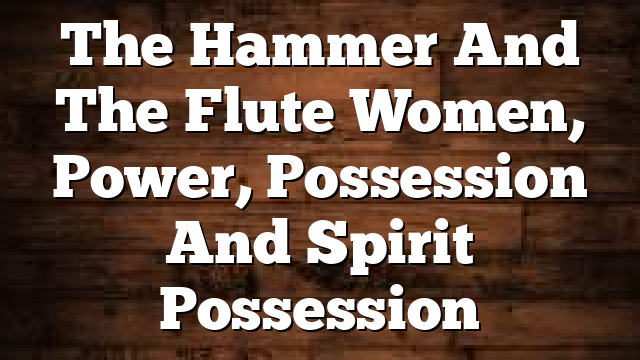Click to join the conversation with over 500,000 Pentecostal believers and scholars
Click to get our FREE MOBILE APP and stay connected
| PentecostalTheology.com



144
Book Reviews / Pneuma 29 (2007) 131-178
Mary Keller, The Hammer and the Flute: Women, Power, Possession and Spirit Possession (Baltimore: Johns Hopkins University Press, 2005). x + 289 pp., $24.95, paper.
The social scientist examines human beings in their cultural environs. In the Hammer and the Flute, Keller selects the realm of gendered spirit possession as a discursive space in which to redefine religion and post-colonial identity, as well as to expand the nomenclature to incorporate useful means of studying nonwestern religious cultures. Keller asserts that through redefinition of power and agency the interpretation of possessed women can be elevated from a seemingly derogatory and limited academic subfield to a place in which spirit, gender, and body are all fluid and interchangeable parts of human existence. All too often, women of color in nonwestern religious traditions are filtered through a Eurocentric lens that does not provide an inclusive or dynamic context.
Spirit possession is an age-old concept in many cultures. Keller was drawn to this subject because of an unusual series of possessions in Malaysia. In 1970 a number of women were being possessed by a variety of harmful entities in a manufacturing plant. Over the course of eight years, the possessions were so volatile that the plant closed and relocated. Keller decon- structs the nature of women’s bodies as well as technology and tradition colliding within the manufacturing plant. Keller is an adjunct faculty member in the religious and African American studies programs at the University of Wyoming, and her research is informed by a feminist, post-colonial worldview that allows a deeper interpretation of possession studies applicable to all nonwestern religions. The limitation of western scholarship hinders many in the academy from viewing possession studies beyond the anachronistic space. To remedy the deficit, scholars need to interpret the agency of possession as a point of “receptivity and permeability beyond the usual, negative associations of passivity and weakness” (8).
The Hammer and the Flute is divided into two parts, each containing three chapters. The first part is “Reorienting Possession in T eory” and the second is “The Work, War and Play of Possession.” The two parts provide the reader with the theory/historiography on posses- sion studies and case studies on historical possessions.
Chapter 1 examines the scholarship of and approaches to possession phenomena by social scientists. Keller explores the works of writers within the three fields of possession studies, scholars such as cultural anthropologist T omas J. Csordas and historian of reli- gions Mircea Eliade. While all three fields of possession studies have strengths, Keller asserts that they are limited by ethnocentric ideals; thus gender and ethnic religious expressions are not fully understood. Chapter 2 examines the scholarship of anthropologist Talal Assad and historian Catherine Bell, both of whom seek a new paradigm to examine religion and pos- session studies in a post-colonial world.
In chapter 3 Keller introduces the notion of instrumental agency as providing a compre- hensive alternative for explaining the possessed body. “Consciousness is overcome, and the body is used like a hammer or played like a flute . . . so that the possessed body is an instru- mental agency in possession” (74). The possessed woman is a vessel selected/created for a specific purpose through which a spirit can orchestrate its mission. The historiography of possession studies has often depicted possessed women as weak vessels whose permeability left them vulnerable. Keller believes that the use of women in possession is not a point of
© Koninklijke Brill NV, Leiden, 2007 DOI: 10.1163/157007407X178355
PPNEU 29,1_f9_131-178.indd 144NEU 29,1_f9_131-178.indd 144
3/30/07 8:48:24 PM3/30/07 8:48:24 PM
1
Book Reviews / Pneuma 29 (2007) 131-178
145
weakness but fertility uniquely ascribed to their gender. T erefore, the paternalistic, ethnocentric lens of possession studies needs to broaden its perspective concerning women and possession.
Keller goes further to explain that the Oxford Dictionary definition of instrumental and agency lend themselves to providing the inclusive paradigm regarding possession studies. The first definition of instrumental applies the hammer-like quality of possession: “The body is wielded by a possessing agency to do work, [like] a volatile hammer” (75). The second definition applies the flute-like quality of possession: “this dimension of instrumen- tality suggests a shifting away from consciousness and toward an idea of a social body developed to receive the power of infinite reality through music” (75). Concurrently the definition of agency deals with place and action. Hence, instrumental agency by definition and those experiencing possession are transformed into a body selected by its activity. In part two the instrumental agency concept is applied in areas of work, war, and plays. Two ethnographic and two theatrical examples are used to understand applied instrumental agency. In these chapters, illustrations of the possessed body are more than a permeable entity: they are cultural memory and expressions of resistance.
In essence, Keller’s work is useful for religious scholars seeking to broaden the nomencla- ture on possession studies and heighten the academic understanding of the actions of spirit forces through human hosts. Pentecostal and, in particular, Afropentcostal scholarship will benefit from Keller’s book for three reasons. First, her work contributes to those seeking to end the demeaning of the concept of possession within religious studies historiography. Second, it enters nonwestern religious cultural expression into the ongoing religious and theological discussion. Finally, it recasts the darkened and gendered body as a place in which cultural communication, resistance, and strength are freely expressed, empowered, and encouraged within alternative societies.
Reviewed by Ida Jones
PNEU 29,1_f9_131-178.indd 145PNEU 29,1_f9_131-178.indd 145
3/30/07 8:48:24 PM3/30/07 8:48:24 PM
2



Anonymous
Link Hudson Isara Mo Roger Lewis William DeArteaga Terry Wiles Joseph D. Absher Brett Dobbs Philip Williams Billy Monroe Poff John Mushenhouse and @everyone else https://www.pentecostaltheology.com/last-days-jezebel-opposing-revival-of-trumps-re-election/
Anonymous
Josh Parchman yes you may!
Anonymous
Sadly, Kilpatrick is clearly ensnared by the principality of right-wing politics that has entrapped so many in our nation. Revival does not depend on the election or non-election of any particular candidate. In our context I’d say the opposite is true: revival is likely in part contingent on repentance from the mixture of church and world in the mode of politicking, especially stumping for the incompetent, and immoral Mr. Trump.
Anonymous
Jack Marsh YES William DeArteaga John Mushenhouse Philip Williams
Anonymous
Troy Day I second that
Anonymous
Jack Marsh but still a bit ugly that you said it that way
Anonymous
Troy Day, please specify why ugly? Is there a better way to speak this truth?
Anonymous
Jack Marsh well not real Christian the way you said it – I understand truth is truth BUT Peter Vandever Ben Bottke Gary Micheal Epping to Kilpatrick related schools and are easily offended about it
TRUTH is Kilpatrick is clearly ensnared by the principality of right-wing politics that has entrapped as you said SO was iHOP after it changed to premin and began supporting TX own NAR politician TedC WAGNER founder of NAR too insisted on various political rightists and Philip Williams tried to sell him millions worth of reality for his new NC political center – not only that but WAGNER operated global network for political influence in South America Europe – they say Ukraine and the Balkans flaring and inflating political votes for sale via his apostles and churches deeply political with the 7 mountains mandate and all Same goes for 700 CLUB who prophesied BOTH sides of Trump winning and NOT winning which William DeArteaga has exposed greatly – NOW we are @ elections 2024 and seems like demonic dems are misleading and destroying churches and pastors that can help TRUMP WIN AGAIN Joseph D. Absher Terry Wiles
Anonymous
Troy Day, yes: I wasn’t singling out Kilpatrick alone, which is why I said ‘ensnared so many;’ but I was responding to the article about Kilpatrick so that’s why I mentioned him. So-called NAR folk are another prime example of not only the abuse of the prophetic (as Kendal and Brown have written about), but also the idolatry at issue – as groups like so-called ‘Prophets for Trump’ and others the past decade so clearly illustrate. I did not mean to offend anyone, and it’s difficult to see how what I wrote was stated unChristianly (perhaps you can model for me how I could have done better?). The problem is pervasive, and so-called ‘progressive’ Christians are ensnared in it too. As you know: anytime we elevate political or cultural categories above biblical ones, it’s idolatrous by definition; and introduces distortions and blind spots (scripture uses the terms strongholds and ‘high thoughts’). Trumpism is one of the clearest examples of this. It has been radically damaging to our witness. In truth: our grandkids will wonder how we could have been so deceived, and a graceful discussion of idolatry and principalities is the first step in biblically understanding how it happened. Note that you do not see, say: AOG central, Vineyard, Calvary Chapel, One Focus, etc. ensnared in this problem. They are properly networked and strive for biblical and theological accountability, which many of our NAR friends abjure. Kilpatrick is a good man of God tragically caught in larger culture of deception and sin, on this matter at least.
Please help me communicate about this with more grace.
Anonymous
Jack Marsh keep on telling the truth brother Philip Williams knows well
Anonymous
Troy Day right wing politics and the “I’ve got to have another new prophecy to keep the crowds coming” method of building.cash cows.
Anonymous
Terry Wiles oh I wouldnt bet on any this right now
Anonymous
This is a totally WOKE and ultimately demonized article about demon-possession, Making Demon possession a social construct rather than what it really is, an evil entity taking possession of another personf ofr destruction. A shame taht PNEUMA published it.
Anonymous
William DeArteaga this is straight from SPS – Book Reviews / Pneuma 29 (2007) 131-178
Mary Keller, The Hammer and the Flute: Women, Power, Possession and Spirit Possession (Baltimore: Johns Hopkins University Press, 2005). x + 289 pp., $24.95, paper.
The Hammer and the Flute is divided into two parts, each containing three chapters. The first part is “Reorienting Possession in T eory” and the second is “The Work, War and Play of Possession.” The two parts provide the reader with the theory/historiography on posses- sion studies and case studies on historical possessions.
Anonymous
God bless you all. There is no legal requirement for churches to be organized as corporations. It is a matter of convenience (limited liability, par example). Pursuant to the IRC 501c (3), churches that meet the requirements of that section are automatically considered tax exempt and are not required to apply for and obtain recognition of exempt status from the IRS as other entities must do. However, also as a matter of convenience, some churches obtain formal recognition. The problem for religious organizations, including churches, comes from the US Supreme Court decision in Bob Jones Univ. v. United States, 461 U.S. 574 (1983) where the Court held that the Government’s fundamental, overriding interest in eradicating racial discrimination in education substantially outweighs whatever burden denial of tax benefits places on a religious organization’s exercise of their religious beliefs. The reason this case has not been widely used in actions against churches is that the Supreme Court has narrowed the requirement to sue on that basis (standing). Notwithstanding, the sword of Damocles is somewhere out there. Well drafted church regulations and financial independence are advisable safeguards.